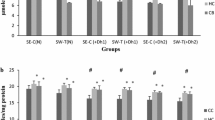Abstract
Trace element content of different tissues might be altered by both age and exercise training. We aimed to determine the effects of a 1-yr swimming protocol (60 min/d, 5 day/wk) on tissue levels and the distribution of zinc (Zn), magnesium (Mg), and copper (Cu) in aging rats. Three groups were formed: sedentary and trained old groups and a young control group. Tissue Zn, Mg, and Cu concentrations were measured in the kidney, heart, liver, lungs, and gastrocnemius and soleus muscles. Kidney zinc concentration significantly decreased in the sedentary old group compared to the young control group (p<0.01) and was significantly higher in the trained old group compared to the sedentary old group (p<0.01), whereas Zn levels in the soleus muscle significantly increased in the sedentary old group in comparison to young controls (p<0.05). Tissue Mg concentrations remained unchanged. The sedentary old group exhibited a significant decrease in kidney Cu concentration compared to the young control group (p<0.01). Although kidney Cu levels also decreased in trained old rats in comparison to young controls (p<0.05), they were significantly higher than in sedentary old rats (p<0.01). The decrease in kidney Zn and Cu content as a result of aging was partly prevented by long-term swimming exercise.
Similar content being viewed by others
References
S. Lekhakul, R. Suphavilai, S. Kritalugsana, et al., Serum levels of zinc and copper in normal subjects, J. Med. Assoc. Thailand 70, 583–585 (1987).
V. W. Bunker, L. J. Hinks, M. S. Lawson, et al., Assessment of zinc and copper status of healthy elderly people using metabolic balance studies and measurements of leukocyte concentrations, Am. J. Clin. Nutr. 40, 1096–1102 (1984).
S. B. Deeming and C. W. Weber, Hair analysis of trace minerals in human subjects as influenced by age, sex, and contraceptive drugs, Am. J. Clin. Nutr. 31, 1175–1180 (1978).
S. I. Baskin, K. P. Kuhar, F. J. Uricchio, et al., The effect of age on five ions of the kidney in the Fischer 344 rat, Reprod. Nutr. Dev. 21, 689–694 (1981).
A. Morita, M. Kimura, and Y. Itokawa, The effect of aging on the mineral status of female mice, Biol. Trace Element Res. 42, 165–177 (1994).
H. R. Massie and V. R. Aiello, Changes with age in cadmium and copper levels in C57BL/6J mice, Mech. Ageing Dev. 11, 219–225 (1979).
I. Rodriguez Tuya, E. Pinilla Gil, M. Maynar Marino, et al., Evaluation of the influence of physical activity on the plasma concentrations of several trace metals, Eur. J. Appl. Physiol. 73, 299–303 (1996).
S. Ganapathy and S. V. Volpe, Zinc, exercise, and thyroid hormone function, Crit. Rev. Food Sci Nutr. 39, 369–390 (1999).
A. E. Olha, V. Klissouras, J. D. Sullivan, et al., Effects of exercise on concentration of elements in the serum, J. Sports Med. Phys. Fitness 22, 414–424 (1982).
A. Singh, P. A. Deuster, and P. B. Moser, Zinc and copper status in women by physical activity and menstrual status, J. Sports Med. Phys. Fitness 30, 29–36 (1990).
G. Haralambie, Serum zinc levels in athletes in training, Int. J. Sports Med. 2, 135–138 (1981).
P. M. Clarkson and E. M. Haymes, Trace mineral requirements for athletes, Int. J. Sports Nutr. 4, 104–109 (1994).
K. Nosaka and P. M. Clarkson, Changes in plasma zinc following high force eccentric exercise, Int. J. Sports Nutr. 2, 175–184 (1992).
H. Ohno, Y. Sato, M. Ishikawa, et al., Training effects on blood zinc levels in humans, J. Sports Med. Phys. Fitness 30, 247–253 (1990).
I. Casoni, C. Guglielmini, L. Graziano, et al., Changes of magnesium concentrations in endurance athletes, Int. J. Sports Med. 11, 234–237 (1990).
P. M. Clarkson, Minerals: exercise performance and supplementation in athletes, J. Sports Sci. 9, 91–116 (1991).
F. J. Navas, J. F. Martin, and A. Cordova, Compartmental shifts of calcium and magnesium as a result of swimming and swimming trainingin rats, Med. Sci. Sports Exerc. 29, 882–891 (1997).
M. Marella, F. Guerrini, P. L. Tregnanghi, et al., Proceedings of the First International Symposium in Metal Ions in Biology and Medicine, pp. 111–113 (1990).
JR Turnlund, N. Durkin, F. Costa, et al., Stable isotope studies of zinc absorption and retention in young and elderly men, J. Nutr. 116, 1239–1247 (1986).
A. S. Prasad, J. T. Fitzgerald, J. W. Hess, et al., Zinc deficiency in elderly patients, Nutr. 9, 218–224 (1993).
A. R. Sherman, L. Helyar, and I. Wolinsky, Effects of dietary protein concentration on trace minerals in rat tissues at different ages, J. Nutr. 115, 607–614 (1985).
N. Fabris and E. Mocchegiani, Zinc, human disease and aging, Aging Clin. Exp. Res. 7, 77–93 (1995).
F. Couzy, P. Kastenmayer, R. Mansourian, et al., Zinc absorption in healthy elderly humans and the effect of diet, Am. J. Clin. Nutr. 58, 690–694 (1993).
L. J. Donaldson, Sport and exercise: the public health challenge, Br. J. Sports Med. 34, 409–415 (2000).
A. Cordova and M. Avarez-Mon, Behaviour of zinc in physical exercise: a special reference to immunity and fatigue, Neurosci. Biobehav. Rev. 19, 439–445 (1995).
D. König, C. Weinstock, J. Keul, et al., Zinc, iron, and magnesium status in athletes—influence on the regulation of exercise-induced stress and immune function, Exer. Immun. Rev. 4, 2–21 (1998).
Author information
Authors and Affiliations
Rights and permissions
About this article
Cite this article
Kuru, O., Sentürk, Ü.K., Gündüz, F. et al. Effect of long-term swimming exercise on zinc, magnesium, and copper distribution in aged rats. Biol Trace Elem Res 93, 105–111 (2003). https://doi.org/10.1385/BTER:93:1-3:105
Received:
Revised:
Accepted:
Issue Date:
DOI: https://doi.org/10.1385/BTER:93:1-3:105




